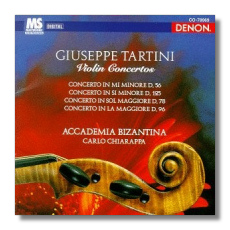
The Internet's Premier Classical Music Source
Related Links
- Tartini Reviews
- Latest Reviews
- More Reviews
-
By Composer
-
Collections
DVD & Blu-ray
Books
Concert Reviews
Articles/Interviews
Software
Audio
Search Amazon
Recommended Links
Site News
 CD Review
CD Review
Giuseppe Tartini

Violin Concertos
- Concerto for Violin D. 56
- Concerto for Violin D. 78
- Concerto for Violin D. 96
- Concerto for Violin D. 125
Carlo Chiarappa, violin
Accademia Bizantina/Carlo Chiarappa
Denon CO-78969 DDD


- Concerto for Violin in A minor "A Lunardo Venier", D. 115
- Concerto for Cello in D Major
- Concerto Grosso #3
- Concerto Grosso #5
- Concerto for Violin in G Major
Chiara Banchini, violin
Enrico Gatti, violin
Roel Dieltiens, cello
Ensemble 415/Chiara Banchini
Harmonia Mundi HMC 901548
Chiarappa plays a sweet-toned Amati from 1651, predating Tartini (1692-1770) himself. His mercurial style seems ideally attuned to the ebb and flow of the music: largos are wistful and sad, allegros darting and fanciful with the florid ornamentation tossed off like birdsong. Accademia Bizantina uses "original instruments" (the extent of the "originality" with regard to tuning, stringing, etc. is not detailed) and are well recorded by Denon. The acoustic is slightly dry and capacious, emphasizing the instruments' reedy sibilance.
The carefully inflected performances of Ensemble 415 make plain the "affetti" (state of emotions) that inform Tartini's work. The Italian violin virtuoso made frequent use of poetry to inspire his composing, sometimes even recording the affecting epigram in the score. Notes accompanying both CDs reviewed here touch on this in some detail: Harmonia Mundi has Gatti's excellent if overachieving reflections; Denon is less well off with a poor translation of a more pertinent essay by Silvia Tuja. Ensemble 415 sounds the more polished group to me, though I prefer Chiarappa to either of its violin soloists. The overall interpretive bent of 415 is one of languor and affliction, whereas Accademia Bizantina, with their rhythmic vigor turned way up ("ours go to eleven!") are positively ecstatic. Perhaps the way Tartini felt during his jam sessions with the orchestra of the Basilica of St. Anthony's in Padua. Since it is my duty to make odious comparisons, I narrowly prefer the Denon record.
Copyright © 1997, Robert J. Sullivan




















